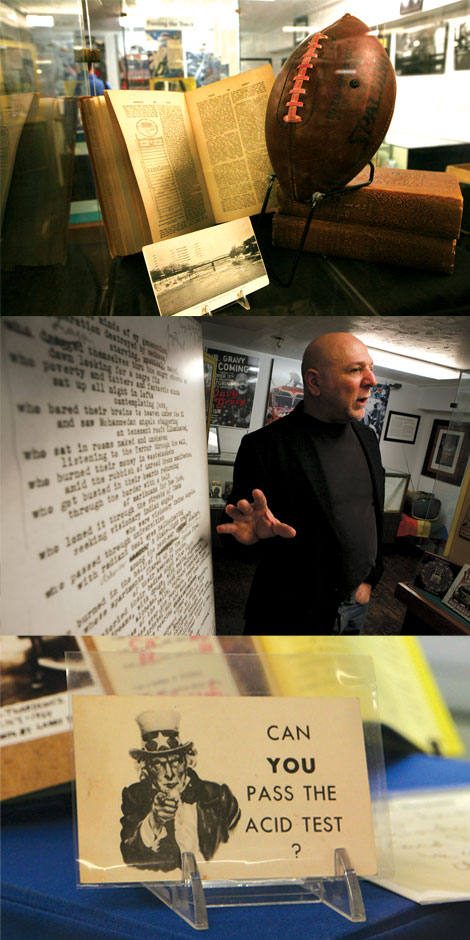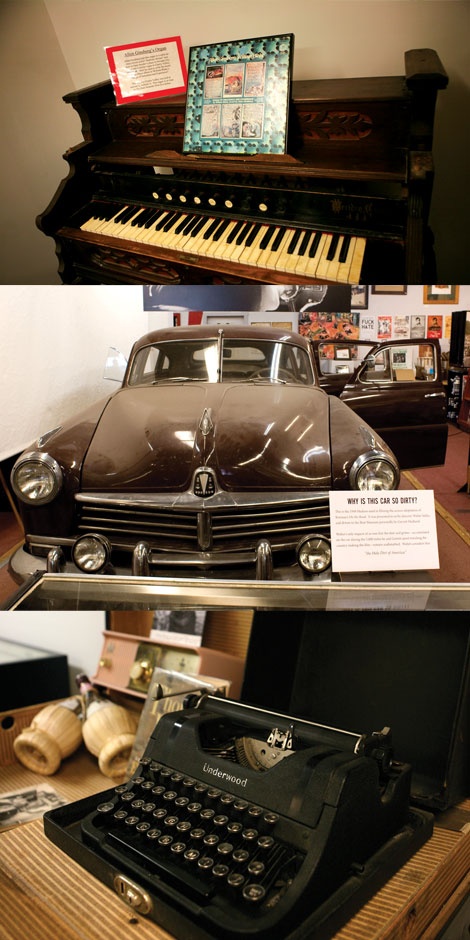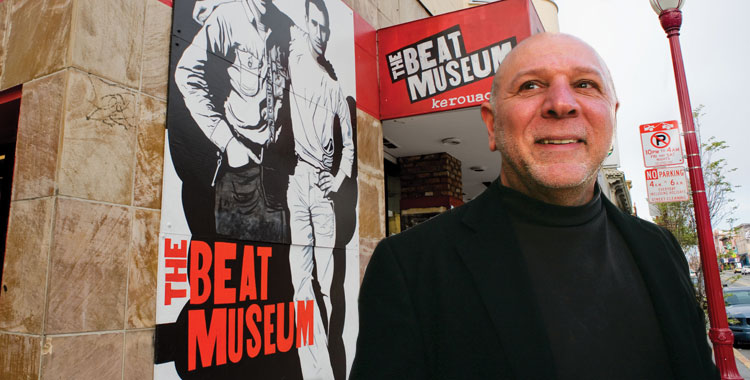At his San Francisco museum, UMBC alumnus Jerry Cimino ’76 makes sure the world is still hep to one of America’s greatest literary movements.
By Jenny O’Grady
Photos by Mirissa Neff and Brittany Powell
The Beat Generation was a uniquely American movement – producing pockets of poetry and art across the land. You could find them in 1950s New York City in their early days clustered around Columbia University – or down in the cafes and jazz clubs of Greenwich Village. Some of them found refuge at Black Mountain College in North Carolina. And they drank and declaimed in juke joints across the Midwest and the Southwest.
That restless urge to explore great spaces is at the heart of Beat verse and prose. But if you had to pick an epicenter of the movement, you’d likely choose San Francisco’s North Beach – and specifically the crossroads of Broadway and Columbus Avenue.
That’s where you’ll find one of America’s great literary meccas: the checkerboard-floored City Lights Books, which was founded by poet/ publisher Lawrence Ferlinghetti in 1953. Right next to it is the Vesuvio Café, a popular watering hole of poets like Allen Ginsberg and Jack Kerouac. And just up the street, at 1562 Grant Avenue, young writers spent hours smoking dope on a crooked stairwell called “Poet’s Corner” – and then headed to the press next door to check galleys of the latest chapbook.
North Beach is also where you’ll find Jerry Cimino ’76, history. From the book-lined open air porch of the Beat Museum, which he founded in 2003 at 540 Broadway to pay homage to a generation of writers and artists who continue to inspire him, he takes in the rich history of this historic section of the city. He savors it. And he can’t help but share it with anyone who will listen.
“What we like to say is: ‘Welcome to the center of the universe,’” enthuses Cimino, with the flair of a modern day P.T. Barnum. “Because you’re at Broadway and Columbus right now – and everything that happened with the Beat Generation happened right here at this intersection.”
The museum’s walls reflect this, exploding with colorful posters, books, author photographs, drawings and videos covering every surface. One wall is devoted completely to editions of Kerouac’s On the Road from around the world. Another shows an early version of Ginsberg’s “Howl,” complete with scrawling edits by the author – enough to make even the biggest bookworm giddy.
More than 60 years after the Beats’ heyday, the culture has found a true evangelist in Cimino, a determined man driven by respect for the inclusive, nonconformist ideals the Beat authors represented. With a little elbow grease – and some recent attention from Hollywood – he’s on the road to making a lasting tribute to his heroes.
“IT KNOCKED ME OUT”

Cimino grew up in the suburbs of Baltimore, the son of a WWII vet-turned-postal clerk. His first encounter with the music and movement of the Beat writers came when a teacher read poems from Lawrence Ferlinghetti’s classic collection A Coney Island of the Mind to his eighth-grade class.
“That whole book of poetry literally changed my life…it knocked me out,” says Cimino, who to this day can recite the book’s fifth poem, “Sometimes During Eternity,” from memory.
“You know, 1968 is when it all happened,” Cimino recalls. “Bobby Kennedy was shot and killed. Martin Luther King was shot and killed. The Vietnam War was raging, and all of us kids were looking at each other and saying, ‘What in the hell are we inheriting?’”
When Cimino arrived at UMBC in 1972, he was among the few students actually living on campus at the time, splitting time between what were then called “Dorms 1, 2, and 3.” He says that many of the bonds that he formed in that era at UMBC – including friendships with older students freshly scarred from serving in Vietnam, and with closeted gays who trusted him with their secret – would forever change his own way of thinking. He also enjoyed some time on stage with the theatre club, sharing the bill (but, sadly, never the stage) with one-time UMBC student Kathleen Turner in a 1975 campus production of Antigone.
“For the first time in my life, I was interacting with a lot of people who weren’t like me,” says Cimino. “And that’s what the Beats were all about – coming together and really celebrating your differences… they were about tolerance and compassion and having the courage to live the most authentic life you can.”
Jonathan M. Cooperman, who roomed with Cimino at UMBC before finishing a degree in physical therapy at the University of Maryland, Baltimore, recalls a thoughtful, passionate friend who also had more hair back then.
“He is very much the same guy to me now as he was then,” says Cooperman, who is now a member of the Beat Museum’s board. “If you walked into his room at three in the morning, the door would be cracked open with light pouring out into the hall. If you walked inside, Jer would be sipping tea and reading a book – usually Kerouac.”
Although he loved history and other subjects he’d studied at UMBC, Cimino graduated without a clear career path to follow. So he went with the flow in which he found himself, relocating to California and forging a successful career in sales for both IBM and American Express.
VOICES THAT SPAN GENERATIONS

Over the years, however, Cimino and his wife, Estelle, started craving something more than a career in business. His continuing affection for the Beat literature he had read as a young man led him to befriend John Cassady – the son of Kerouac’s friend Neal Cassady, who is immortalized in the character of “Dean Moriarty” in On the Road.
Cimino also began building a collection of Beat generation memorabilia which eventually became “The Beat Museum on Wheels” in 2003. And just as Dean Moriarty took off across the country with Sal Paradise (the character representing Kerouac himself in On the Road), Cimino and Cassady drove “the mighty beatmobile” across America’s highways in October 2005 – even parking it overnight in Commons Circle at UMBC.
Cimino says he reveled in the chance to share his growing collection with UMBC students and see his old campus. And faculty members were happy to have a bit of the Beats in Catonsville.
“The students enjoyed visiting the museum on wheels, with all kinds of interesting, hard-to-get publications and memorabilia, and just hanging out with Jerry and John,” says UMBC associate professor of English Piotr Gwiazda, who helped organize the appearance.
The Beats cast a spell over today’s students now just as much as ever, Gwiazda says.
“Whenever I teach ‘Howl,’ students respond with interest,” he says. “There still seems to be something magnetic about the work of Beat Generation writers: the idea of community it embodied, its counter-cultural aspects, its philosophical dimensions, and of course its sheer verbal power and vitality.”
STAR POWER
Of course, interest in the Beats has never been limited to college students reading in circles on the grass. A new Hollywood treatment of Kerouac’s On the Road – which features Kristen Stewart of Twilight fame and Viggo Mortensen from the Lord of the Rings films – is traveling the festival circuit now and scheduled for general release later this year.
Cimino couldn’t be happier about what the new film means for the legacy of the Beats – and for the future of his own museum.
“It’s just great, have you seen it?” he says, cueing up the movie trailer on a screen above the museum’s entrance. Since filming began in 2010 under director Walter Salles, Cimino says members of the film’s cast have visited the museum and asked questions about their characters.
The cast and crew even dropped off a surprise prop from the film at the museum. Just to the right of the museum’s check-in desk sits a dusty maroon 1949 Hudson Hornet used during filming and driven to its resting spot in North Beach by none other than the movie’s star Garrett Hedlund (“a really delightful young man,” says Cimino), who portrays the everrestless Dean Moriarty.
Beside it stands a sign: “Walter’s only request of us was that the dust and grime – accumulated on the car during the 5,000 miles he and Garrett spent traveling the country making the film – remain undisturbed. Walter considers this ‘the Holy Dirt of America.’”
“You know, every fingerprint has a story,” says Cimino. “It’s important to keep that history intact.”
That’s a major part of Cimino’s job as curator: making the story of the Beats accessible and fun for anyone who might wander in. He loves every second of his evangelism for the movement and its great writers.
“The museum is successful because it represents a significant part of American culture and American literary history,” says Cooperman. “The opening of the movie On the Road demonstrates how this literature is still relevant.
“Of course, the fact that Jerry is probably as knowledgeable of the Beats as any academic doesn’t hurt either,” he adds. “He’ll ultimately be successful because he has a passion for what he does.”
NOW AND LATER
Passion is one thing. But, if you’re wondering how a start-up museum makes it in such difficult economic times, here’s your answer: It ain’t easy.
But the Beat Museum now survives and thrives thanks to Cimino’s magnetic business sense and a lot of hard work.
Just above Cimino’s desk hangs a complicated organizational chart showing a collage of boxes representing duties spanning everything from marketing to merchandising to fixing the guest toilet. One line connects them all.
“And every one of those boxes has my damn name on it,” he jokes. “That’s just how it is.”
The museum’s collection has grown as fans discover it. Cimino admits that “most people who love the Beats don’t have a lot of money,” but as fans of certain writers have discovered his museum, the memorabilia contributions have flowed in steadily. There’s a plaid jacket once worn by Kerouac, and a creaky pipe organ owned by Allen Ginsberg. There’s even an original “Can YOU pass the acid test?” card from the days when Neal Cassady drove Ken Kesey and the Merry Pranksters across the country in a psychedelic bus – a trip immortalized by author Tom Wolfe in his 1968 book, The Electric Kool-Aid Acid Test. (There’s also a film version of that book in works, to be directed by Gus Van Sant.)
Over the years, Cimino also found mentors to advise him as his plans for the museum have grown. He singles out the late Kim Greer, who was president of the National Steinbeck Center in Salinas, California, until his death in 2006.
“I have people come in every day telling me what I should be doing,” he says. “But I only take advice from people who have successfully done what they’re telling me I ought to do. It’s easy to guess…but that’s not going to get you anywhere.”
Right now, the Beat Museum is just as Cimino would like it to be: full, eclectic, engaging. Not too smooth, or too uniform: that wouldn’t fit well with the artists that it celebrates. Mismatched shelves offer hand assembled chapbooks by local poets. A claw-footed bathtub filled with dime store novels invites visitors to try something new. There’s a definite flavor to the place – a sort of San Francisco sourdough bite.
Cimino would enjoy having someone else fix the toilet from time to time. More important, however, is growing the Beat Museum so that it can stand strong for generations to come. That’s his next step.
“I started this place the only way I know how. I built it from nothing,” he says. “Now we’ve built a track record, we’ve made it succeed with the blood and sweat of a lot of people. If this thing’s going to outlive me…I’m going to have to think big.”
- VIDEO: Interview with Jerry Cimino ’76, founder of The Beat Museum
- Read Jerry’s blog from his 2005 visit to UMBC
- Read Jerry’s review of Walter Salles’s new movie, On the Road


